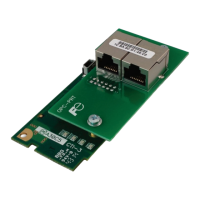8) By double-clicking “Controller Tags” in the project
tree, it is possible to view the newly-added tags.
Refer to Figure 56. The Interface_Card:C
configuration tag is unused, the Interface_Card:I
tag allows viewing of the input data, and the
Interface_Card:O tag allows modification of the
output data. These tags will be synchronized with
the inverter at whatever rate was established for
the module’s RPI.
9) By double-clicking “Controller Tags” in the project
tree, it is possible to view the newly-added tags.
Refer to Figure 56. The Interface_Card:C
configuration tag is unused, the Interface_Card:I
tag allows viewing of the input data, and the
Interface_Card:O tag allows modification of the
output data. These tags will be synchronized with the inverter at whatever rate was established for
the module’s RPI.
Figure 56: Controller Tags for I/O Access
W e can directly interact with these tags in order to control and monitor the inverter. In Figure 56,
for example, we can see that the first 16-bit word of output data (Interface_Card:O.Data[0]) has
been set to a hexadecimal value of 0x0001. The default consumed data word configuration word
offset 0 references function code S06, which is the inverter’s command register. A value of
0x0001, therefore, means that the FW D (run forward) bit has been turned ON.
Similarly, we can see that the second 16-bit word of output data (Interface_Card:O.Data[1]) has
been set to a decimal value of 3558. The default consumed data word configuration word offset 1
references function code S05, which is the inverter’s frequency command register. A value of
3558, therefore, equates to a frequency command of 35.58Hz.
The input data from the inverter shows similar expected results. Values of 0x1021 and 3558
corresponding to M14 (status register) and M09 (output frequency), respectively, are consistent
with the inverter running at the parameters commanded by the output tag.
9.2.12.1 ControlLogix Example: Generic Default I/O Add-On Instruction
The generic default I/O add-on instruction is a simple interface to command and monitor the inverter. It is
based on the vendor-specific assembly instances 100 & 150 and the default produce and consume data
configuration (refer to section 9.2.4). The add-on instruction is optional and provided for user
convenience.
1) Complete all the steps in section 9.2.11.
2) Right click on “Add-On Instructions” in the controller organizer view and select “Import Add-On
Instruction”. Browse and import the generic default I/O add-on instruction. Refer to Figure 57.
Figure 55: Online Module Status

